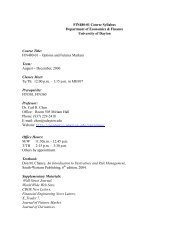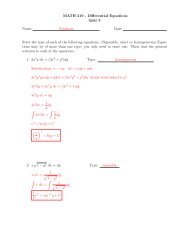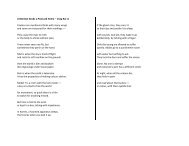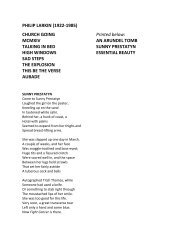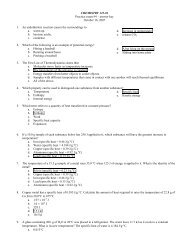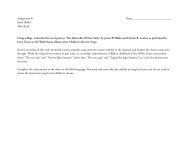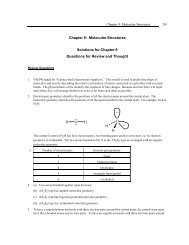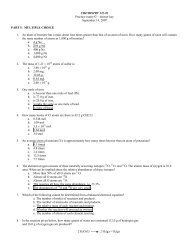CHEMISTRY 314-01 MIDTERM # 1 – answer key September 29 ...
CHEMISTRY 314-01 MIDTERM # 1 – answer key September 29 ...
CHEMISTRY 314-01 MIDTERM # 1 – answer key September 29 ...
Create successful ePaper yourself
Turn your PDF publications into a flip-book with our unique Google optimized e-Paper software.
200<br />
175<br />
n-propyl group; typical pattern<br />
of triplet (CH 3), multiplet (CH 2)<br />
and triplet (CH 2)<br />
150<br />
125<br />
100<br />
para-disubstituted benzene ring; typical<br />
pattern of two doublets of equal intensity<br />
O O<br />
H<br />
75<br />
50<br />
25<br />
aldehyde H-atom; shifted<br />
far downfiled (9 - 10 ppm)<br />
14. (2 pts) Among the following structures, circle the compound that has one signal in its 1 H NMR and two signals in its 13 C NMR:<br />
O O<br />
F F<br />
H 3C CH 3<br />
15. (2 pts) In class, our NMR discussion started with just the hydrogen nucleus, without any electrons. If you were able to run an 1 H<br />
NMR spectrum of a sample of H-nuclei (e.g. some H + in the gas phase), where would you expect to find the signal:<br />
A. Far downfield, δ > 10 ppm.<br />
B. Within the typical range for hydrogen, 10 > δ > 0 ppm.<br />
C. Far upfield, δ < 0 ppm.<br />
Briefly account for your choice: The H-nucleus is not shielded at all, since there isn’t any electron density around it.<br />
When nuclei are not shielded (or, alternatively, heavily deshielded), then their signals experience considerable downfield<br />
shifts. Thus, one would expect the signal for the H-nucleus to be found far downfield, with chemical shift value δ > 10<br />
ppm.<br />
16. (3 pts) Among the isomeric alkenes C4H8, suggest the structure that would exhibit 4 signals in its 1 H NMR spectrum.<br />
17. (4 pts) In the mass spectrum of 2-methyl-2-pentanol, among other signals, there are two prominent peaks at m/z = 87 and m/z =<br />
59. Suggest structures for the species that are responsible for these signals and the fragmentation that leads to them from the<br />
molecular ion.<br />
Solution: Since the signals are prominent, they must correspond to very typical alcohol fragmentations. It turns out that both<br />
signals in question are generated by the same type of fragmentation: α-cleavage.<br />
+<br />
OH<br />
OH<br />
m/z = 59 m/z = 102<br />
Cl<br />
Cl<br />
OH<br />
m/z = 87<br />
+ CH 3




